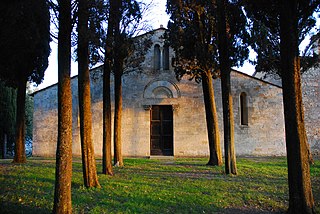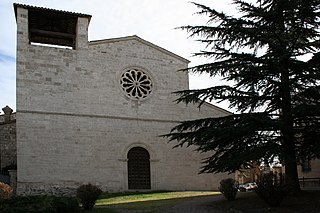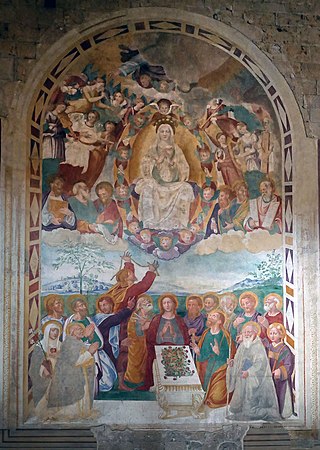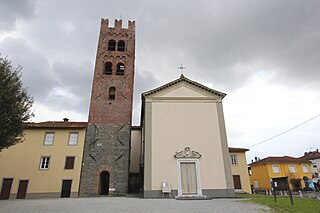
Montalcino is a hill town and comune in the province of Siena, Tuscany, central Italy.

Arezzo is a city and comune in Italy and the capital of the province of the same name located in Tuscany. Arezzo is about 80 kilometres southeast of Florence at an elevation of 296 metres (971 ft) above sea level. As of 2022, the population was about 97,000.

Pistoia is a city and comune in the Italian region of Tuscany, the capital of a province of the same name, located about 30 kilometres (19 mi) west and north of Florence and is crossed by the Ombrone Pistoiese, a tributary of the River Arno. It is a typical Italian medieval city, and it attracts many tourists, especially in the summer. The city is famous throughout Europe for its plant nurseries.

Spello is an ancient town and comune (township) of Italy, in the province of Perugia in eastern-central Umbria, on the lower southern flank of Mt. Subasio. It is 6 km (4 mi) NNW of Foligno and 10 km (6 mi) SSE of Assisi. It is one of I Borghi più belli d'Italia.

Pratovecchio Stia is a comune in the province of Arezzo, Tuscany. It was formed by the merger of the two former comuni of Pratovecchio and Stia in 2014.

Greve in Chianti is a town and comune (municipality) in the Metropolitan City of Florence, Tuscany, Italy. It is located about 31 kilometres (19 mi) south of Florence and 42 kilometres (26 mi) north of Siena.

Monteriggioni is a comune in the province of Siena in the Italian region of Tuscany. It borders on the communes of Casole d'Elsa, Castellina in Chianti, Castelnuovo Berardenga, Colle di Val d'Elsa, Poggibonsi, Siena, and Sovicille. The town is architecturally and culturally significant; it hosts several piazzas, and is referenced in Dante Alighieri's Divine Comedy.

Castelfiorentino is a city and comune (municipality) in the Metropolitan City of Florence, Tuscany, central-northern Italy, halfway between Florence, Pisa (45 km) and Siena (55 km). The population is approximately 20,000 inhabitants. It is part of Valdelsa. Castelfiorentino borders the following municipalities: Certaldo, Empoli, Gambassi Terme, Montaione, Montespertoli and San Miniato.

San Casciano in Val di Pesa is a comune (municipality) in the Metropolitan City of Florence in the Italian region Tuscany, located about 15 kilometres (9 mi) southwest of Florence.

Tavarnelle Val di Pesa is a former comune (municipality) and since 2019 a frazione of Barberino Tavarnelle in the Metropolitan City of Florence in the Italian region Tuscany. It is located about 25 kilometres south of Florence.

Castellina in Chianti is a comune (municipality) of c. 2,800 inhabitants in the province of Siena, in the Italian region Tuscany, located about 35 kilometres (22 mi) south of Florence and about 15 kilometres (9 mi) northwest of Siena. It is part of the Chianti Hills, between the valleys of the Arbia, Pesa and Elsa rivers.

Gaiole in Chianti is a comune (municipality) in the Province of Siena in the Italian region Tuscany, located about 40 kilometres (25 mi) southeast of Florence and about 15 kilometres (9 mi) northeast of Siena. Forbes named it number one in its list of "Europe's Most Idyllic Places To Live."

Prato Cathedral, or Cathedral of Saint Stephen, is a Roman Catholic cathedral in Prato, Tuscany, Central Italy, from 1954 the seat of the Bishop of Prato, having been previously, from 1653, a cathedral in the Diocese of Pistoia and Prato. It is dedicated to Saint Stephen, the first Christian martyr.

The Castello della Magione is a medieval castle in Poggibonsi. It is an example of a medieval "Mansio" (residence) that belonged to the Knights Templar. The castle includes the ancient church and the “spedale” (hotel) for the pilgrims in transit to Rome on the Via Francigena. The complex is near the ancient crossing of the Via Francigena over the Staggia River, near the Bonizio bridge, now destroyed.

Santa Maria Assunta in Cellole is a church and former pieve located in Pancole, in the municipality of San Gimignano, province of Siena, Tuscany, central Italy. Mentioned for the first time in 1109, it was rebuilt several times between the 12th and 13th centuries, and was consecrated in 1238.

Montelaterone is a village in Tuscany, central Italy, administratively a frazione of the comune of Arcidosso, province of Grosseto, in the area of Mount Amiata. At the time of the 2001 census its population amounted to 283.

San Pietro a Cedda is a Romanesque-style, former Roman Catholic church located in the frazione of Cedda in the town of Poggibonsi, Province of Siena, region of Tuscany, Italy.

San Vittore is a Romanesque and Gothic-style, Roman Catholic church located in the town of Ascoli Piceno in the region of Marche, Italy.

The Badia of Santi Salvatore e Cirino or in English the Abbey of Saints Salvatore and Cirino is a former Cistercian monastery located in Abbadia a Isola, west of the village of Monteriggioni, in the province of Siena in the Italian region of Tuscany. The abbey is also known as the Badia a Isola or Abbazia dei Santi Salvatore e Cirino. The monastic buildings include an inn, restaurant and halls for cultural events.

The Pieve di San Frediano is a rural parish church, originally founded in the 8th century, and located in Lunata, a hamlet of the town of Capannori, province of Lucca, region of Tuscany, Italy.



























